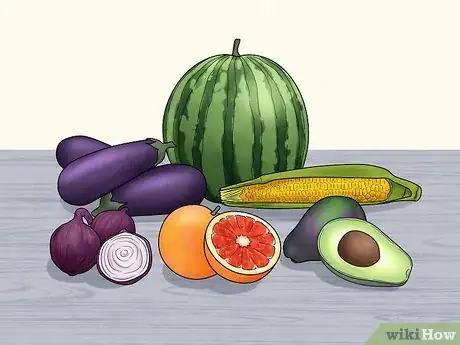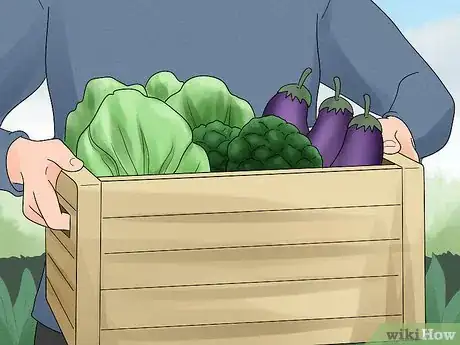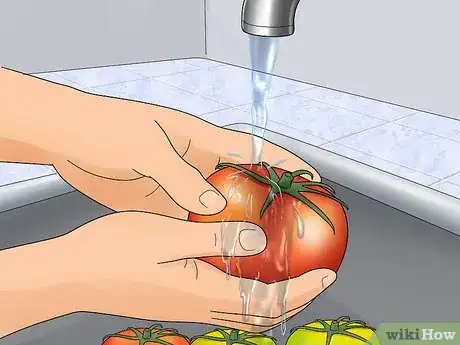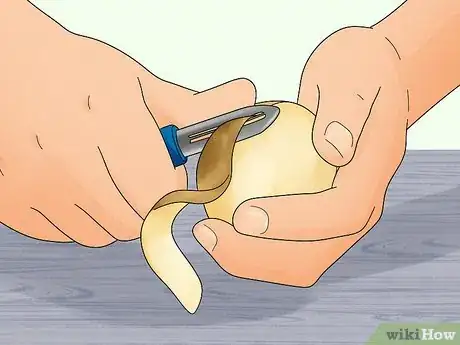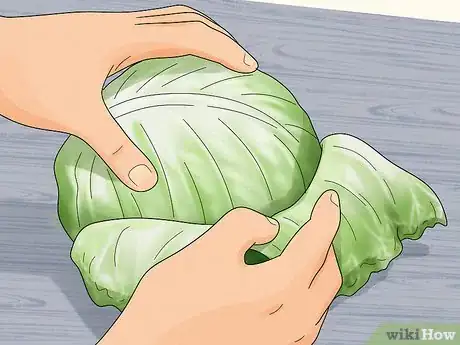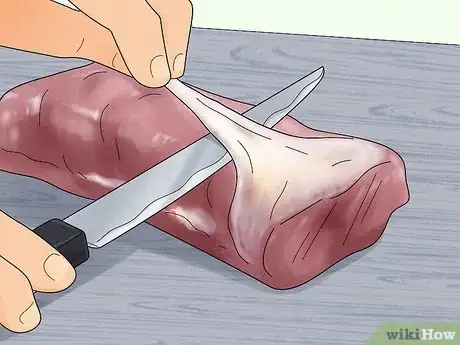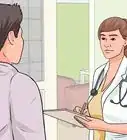This article was co-authored by Georgia Grey and by wikiHow staff writer, Hannah Madden. Georgia Grey is a Holistic Health Coach and the Owner of Whole Body Healing Nutrition. With more than five years of experience, she specializes in autoimmune disorders, Lyme disease, and inflammation. Georgia earned a BA from Southern Methodist University and a Degree in Advanced Hormone Health from the Institute of Integrative Nutrition. She is also a Certified Holistic Health Coach through the Institute for Integrative Nutrition and a Certified Holistic Health Practitioner through the American Association of Drugless Practitioners.
This article has been viewed 10,782 times.
When you buy food from the grocery store, pesticides are unavoidable. While studies show that minimal amounts of pesticide residue in food isn’t harmful, it’s still a good idea to avoid it when you can, since even small amounts can build up in your body over time. In this wikiHow, we’ve compiled 11 ways you can reduce the pesticide residue in your food both in your shopping practices and after you get home.
Steps
Buy a variety of fruits and vegetables.
-
This will help minimize the risk of exposing yourself to a single pesticide. Since fruits and vegetables usually use different pesticides in their production, if you buy a variety of them, you won’t have a buildup of one single pesticide in your body. Plus, eating a variety of fruits and veggies is a great way to maintain a healthy diet, so it’s a great idea all around![1] X Trustworthy Source National Pesticide Information Center Organization run by Oregon State University providing objective, science-based information about pests and pesticides Go to source
- You can make this easier on yourself by going for what’s in season. That way, your purchases will change throughout the year (and your produce will be fresher, too).
Look for produce that is exposed to fewer pesticides.
-
There are 15 main produce items that have very little pesticide residue. In general, onions, sweet corn, pineapple, avocado, cabbage, sweet peas, asparagus, mangoes, eggplant, kiwi, cantaloupe (domestic), sweet potatoes, grapefruit, watermelon, and mushrooms don’t use as many pesticides in their production.[2] X Research source To lower your risk of pesticide exposure, go for these types of produce primarily.
- There is also produce that has much higher pesticide exposure over time. These are often called “the dirty dozen,” and they include apples, celery, sweet bell peppers, peaches, strawberries, nectarines (imported), grapes, spinach, lettuce, cucumbers, blueberries (domestic), and potatoes.[3] X Research source
Go for organic produce when you can.
-
In general, organic produce isn’t exposed to as many pesticides. Organic farmers use natural and holistic principles to get rid of pests rather than using pesticides. If you can, try to go for organic products at the store—just keep in mind that they may be more expensive than non-organic foods.
- While some research supports this, other studies say that even organic produce can contain pesticide residue.[4] X Trustworthy Source National Pesticide Information Center Organization run by Oregon State University providing objective, science-based information about pests and pesticides Go to source Organic products might be slightly better, but they aren’t completely clean.[5] X Research source
Get your produce from a local farmer’s market.
-
You can ask the farmers about their pesticide use. Usually, farmer’s markets will have real people from the farm working their stands. You can chat with them about what they’re doing to minimize pesticide residue in their food before you buy it. Plus, farmer’s market produce is usually much fresher (and it even tastes better, too).[6] X Trustworthy Source National Pesticide Information Center Organization run by Oregon State University providing objective, science-based information about pests and pesticides Go to source
- Most farmer’s markets happen during the spring, summer, and fall when the weather is nice.
- Keep in mind that purchasing produce from a farmer’s market is usually more expensive than buying it from your local grocery store.
Grow your own produce to minimize exposure to pesticides.
-
You can avoid using pesticides in your own garden. When you keep a garden, you know exactly where your food is coming from. If you don’t have space in your own yard, consider checking out a community garden nearby. You can usually rent a space to grow and maintain at your leisure.[7] X Trustworthy Source National Pesticide Information Center Organization run by Oregon State University providing objective, science-based information about pests and pesticides Go to source
- Different veggies thrive during different seasons and in different parts of the globe. Before you start your vegetable garden, look online to see what kind of produce you should start with and when to plant it.
Wash your produce in running water.
-
Running water is abrasive, which can help wash off pesticides. Before you eat any of your produce, take it home and hold it under running water for about 1 minute. You can gently scrub your produce with your fingers to get rid of dirt, bacteria, and residual pesticides, although experts warn that washing your produce probably won’t get rid of all pesticide residue.[8] X Trustworthy Source United States Environmental Protection Agency Independent U.S. government agency responsible for promoting safe environmental practices Go to source
- While you may have heard that you need to use soap or produce wash, the U.S. Food and Drug Administration (FDA) says that running water is just fine.[9] X Trustworthy Source US Food and Drug Administration U.S. government agency responsible for promoting public health Go to source Produce is porous, and can actually absorb the soap or wash that you use, which can make you sick.
Scrub any firm produce under running water.
-
Melons and root vegetables might need a bit more than a rinse. When you wash these firm fruits and veggies, grab a soft produce brush and gently scrub the outside under the water. This will help get into any cracks and crevices to really wash your produce thoroughly.[10] X Trustworthy Source National Pesticide Information Center Organization run by Oregon State University providing objective, science-based information about pests and pesticides Go to source
- Root vegetables include carrots, potatoes, radishes, and beets.
- If you don’t have a produce brush, you can just use your fingers.
Dry produce with a clean towel.
-
This last step in the cleaning process will help remove pesticide residue. When you’re done washing your produce, grab a clean towel (or a paper towel) and thoroughly dry the outside of your fruits or veggies. Plus, this cuts down on drying time, so you won’t have to deal with your produce dripping everywhere as you try to cook with it.[11] X Trustworthy Source National Pesticide Information Center Organization run by Oregon State University providing objective, science-based information about pests and pesticides Go to source
Peel or trim your produce whenever possible.
-
Most pesticides sit on the outermost layer of your produce. Whenever you can, try to peel the skin off your produce before you eat it. Not only will this help reduce pesticide residue, but it will also get rid of any residual dirt or bacteria.[12] X Trustworthy Source United States Environmental Protection Agency Independent U.S. government agency responsible for promoting safe environmental practices Go to source
- Try peeling potatoes, carrots, cucumbers, and zucchini.
- Keep in mind that peeling your produce can remove some of the essential nutrients.
Throw away the outer layer of leafy vegetables.
-
Cabbage and lettuce can have pesticide residue on their outer layers. Before you dive in, rip off that outer layer and throw it away to avoid ingesting any of it. You can do this before or after you rinse—either way is fine.[13] X Trustworthy Source National Pesticide Information Center Organization run by Oregon State University providing objective, science-based information about pests and pesticides Go to source
- Some leafy vegetables come “pre-washed” or “ready-to-eat.” If that’s the case, you technically don’t need to wash them before eating.[14] X Trustworthy Source US Food and Drug Administration U.S. government agency responsible for promoting public health Go to source
Trim the fat off meat and fish before you eat it.
-
Pesticides tend to accumulate in the fat of animals. If you eat meat, use a knife to trim off most of the fat from meat, fish, and poultry whenever possible. If you’re buying your meat from a deli, you can usually ask the person behind the counter to trim it for you before you take it home.[15] X Trustworthy Source United States Environmental Protection Agency Independent U.S. government agency responsible for promoting safe environmental practices Go to source
- Pesticides accumulate in animals when they eat crops that have been contaminated. They can also accumulate when animals eat another animal that has eaten pesticides.
You Might Also Like
 Is My Yogurt Bad?: 7 Signs
Is My Yogurt Bad?: 7 Signs
 How to Monitor Your Weight at Home Without a Scale
How to Monitor Your Weight at Home Without a Scale



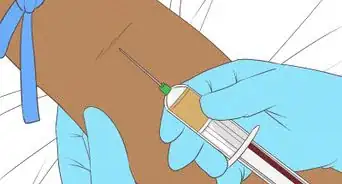
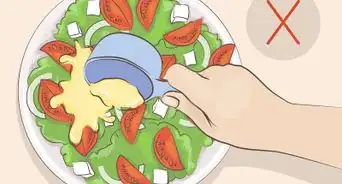

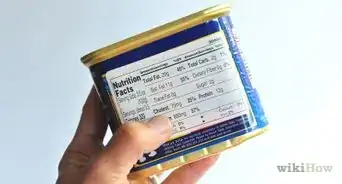

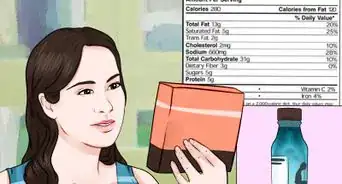


References
- ↑ http://npic.orst.edu/health/foodprac.html
- ↑ https://depts.washington.edu/ceeh/downloads/FF_Pesticides.pdf
- ↑ https://www.ewg.org/foodnews/dirty-dozen.php
- ↑ http://npic.orst.edu/health/foodprac.html
- ↑ https://ncceh.ca/sites/default/files/Organic_Diet_May_2010.pdf
- ↑ http://npic.orst.edu/health/foodprac.html
- ↑ http://npic.orst.edu/health/foodprac.html
- ↑ https://www.epa.gov/safepestcontrol/pesticides-and-food-healthy-sensible-food-practices
- ↑ https://www.fda.gov/food/buy-store-serve-safe-food/selecting-and-serving-produce-safely
- ↑ http://npic.orst.edu/health/foodprac.html
- ↑ http://npic.orst.edu/health/foodprac.html
- ↑ https://www.epa.gov/safepestcontrol/pesticides-and-food-healthy-sensible-food-practices
- ↑ http://npic.orst.edu/health/foodprac.html
- ↑ https://www.fda.gov/food/buy-store-serve-safe-food/selecting-and-serving-produce-safely
- ↑ https://www.epa.gov/safepestcontrol/pesticides-and-food-healthy-sensible-food-practices
About This Article


